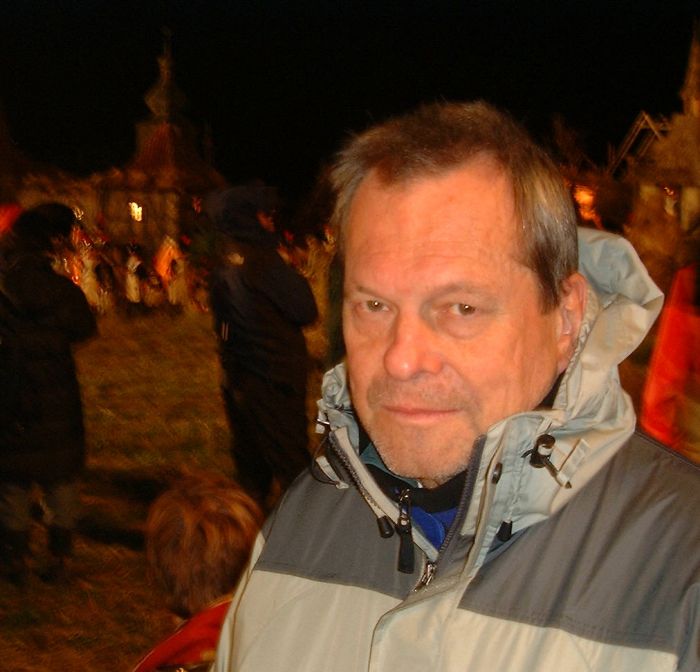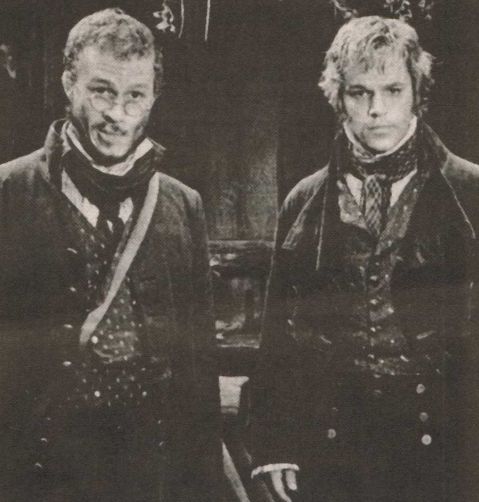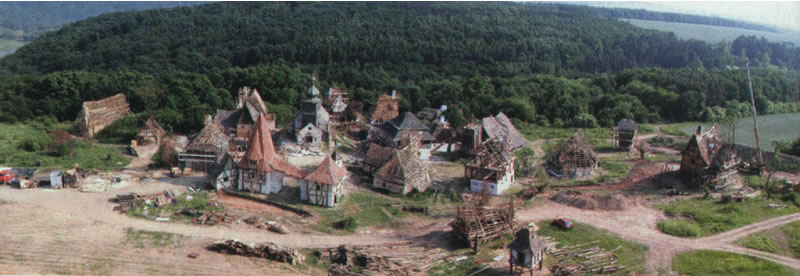Dreams: On the set of The Brothers Grimm
Part One... by Phil Stubbs |
|
Gilliam during the night shoot
pic by Phil Stubbs |
Film director Terry Gilliam is back to work. This is a good thing. After all, it's more than six years since his last film Fear and Loathing in Las Vegas started shooting. In recent months, he has been making a picture called The Brothers Grimm at the Barrandov Studios in Prague, with a sizeable budget and an enviable cast. Loosely based on the stories collected by the real Brothers Grimm of the nineteenth century, the film features Matt Damon, Heath Ledger, Jonathan Pryce, and Peter Stormare. I paid a visit to the Czech Republic set in September. I was to visit a couple of night shoots. "Bring warm clothes and be prepared", I was warned, "for cold and wet weather".
It's 8pm, and I'm collected at my Prague hotel to be taken to Barrandov in Gilliam's black Mercedes. Whisking straight past security and the studio buildings, we stop in a car park full of trailers. I am met by Terry's daughter Amy who is working as his assistant, and I'm escorted to the set. I am instructed to remain very quiet during shooting, to have my phone turned off and never walk in front of the camera while it's shooting. Sensible advice indeed. Equipped with a tight-fitting pair of Wellington boots borrowed from the director's trailer, I head towards the studio backlot. It's day 51 of the shoot.
We are on a hill overlooking the city of Prague, with its romantic attractions shimmering in the distance. As I approach the set, my eyes are drawn to a delightful constructed village to my left. It is extremely bright, since it is floodlit by enormous lights on my right, which are themselves just in front of a forest of very tall trees. I say a forest... it is in fact a thin stretch of imported trees giving a good impression of being a forest. In the middle is an acre or two of grassland where the members of the film crew are standing, setting up the first shot of the night. I'm told that not only has the village been built, but the trees and the grass have been brought in to create this external set.
It's cold, it's dark, and it's damp. I lurk behind the monitors where the acting talent have their seats, not that any of the stars are here at the moment. The food tent is pointed out to me, and it's not long before I help myself to something to get me through the night. The first of many visits.
 |
|
The Brothers Grimm
pic: Francois Duhamel |
I see dozens of people working hard setting up the first shot of the
evening. And in the middle of everything is the director of the project,
Terry Gilliam. It's not been an easy road for Gilliam over the last few
years. After his last film was released in 1998, Gilliam threw himself
into a project The Man Who Killed Don Quixote, which came a cropper
after just a few days, due to bad weather and injury - the events of which
were captured in the documentary film Lost in La Mancha. Then he
spent a year on Good Omens, and a number of other potential projects
which came to nothing. Not having been able to get any of his own movie
projects off the ground, he's taken on a studio project, a script by Ehren
Kruger with Dimension Films providing funding. Gilliam fans will be cheered
by the news that he and his co-writer Tony Grisoni have been given some
freedom to rewrite the script, to shape the material in a more Gilliamesque
fashion.
Gilliam finds a moment to have a quick chat with me. Among other things,
he tells me that he's particularly pleased with the performances his actors
have given. There's no sign of a documentary crew on this set, and fortunately
there's not the sense of doom and disaster that affected Quixote
either. But the events are being recorded by Gilliam biographer Bob McCabe
who is on set to write a book about the making of the film.
The key members of the filmmaking hierarchy (Assistant Directors, Continuity,
Director of Photography) are linked with wireless communication devices,
so no matter where I hang around, it's quite difficult at any moment to
work out exactly what is happening.
As I've said, Gilliam and crew are setting up the first shot of the day.
There's only one actor in this shot - a young girl wearing a red-hood,
reflecting the Grimm roots of this script.
The camera has its back to the thin forest, and is facing the village.
The camera is placed upon a crane which is in turn moving on a track.
In the shot, the girl runs away from the camera towards the village in
the background. She falls to the ground as the camera moves towards her.
Her face and the village is lit up mid-shot suggesting she's witnessing
an explosion. There is an enormous and loud fan behind the camera to simulate
a blast on the girl and which also blows straw onto her. Straw is dropped
in front of the fan during each take.
Just after 9pm, we're ready for take one. Takes two and three follow soon
after. After four takes, Gilliam says he's happy with it. But he then
says, "Let's do one more." He has a better idea. After take
eight, Gilliam describes it as "Wonderful", but asks for another.
Ten o'clock goes past, and we're onto take ten. The director giggles "great".
In the next few takes, there are more problems as the girl keeps on making
mistakes. In between each take the girl's hair stylist recreates the girl's
hair. He finds that putting the curling tongs in front of the stars' red-hot
oil heater helps him get the right style each time.
By this time, Heath Ledger has appeared to find out what's going on. He
arrives on set with a pal wearing a rugby shirt and throwing a rugby ball.
He chats for a bit with various members of the crew. Heath, who's required
to perform later, leaves the set throwing ball to his pal. They depart
quickly but almost appearing in a vital take in modern attire. Jonathan
Pryce also turns up and has a chat with Gilliam. Pryce just flew in today
- he's required tomorrow but popped down to the set to see how things
were going.
By 11:30pm the crew has completed take twenty of the shot with the girl
- this is to be the final take, the last few shots having been done with
a wider angle.
Tonight I witness a continuous shoot throughout the night, which means
no breaks for cast or crew. This presumably to minimise the number of
days the cast and crew have to work nights. But the food tent remains
open all night supplying drinks and snacks for all.
The Brothers Grimm is being shot on film. Within the camera is
a further digital device which is used to feed the monitors around the
set. The monitors are used by Gilliam and the DP to set-up each shot.
And during shooting, not only are the moving images captured on film,
but they are recorded digitally to provide an immediate record to ensure
continuity. Working on set is an editor of the digital output, linked
to the wireless communication system, who is able to replay any take to
the monitors on demand. Gilliam and his DP Tom Sigel have monitors just
near the camera, and there are further monitors situated for the seats
reserved for the cast.
For the two days I was on set, Gilliam spent all of his time with the
main unit for ten hours each day, seemingly taking no breaks. As on any
movie shoot, the set-ups take significant time, as the elements in the
shot are arranged and the camera is set-up. The assistant directors and
DP have planned their work so they don't need constant supervision from
Gilliam, but the director talks to the cast, tests things out and makes
himself available to answer questions. When the set-up is complete, Gilliam
sits down behind the camera with his DP looking at the digital monitors,
ensuring that each shot is perfectly composed. From there the DP can control
the camera using levers. Where necessary, this is then compared with a
previous shot recorded digitally - to ensure continuity.
When action is called, Gilliam carefully examines what is being captured
by looking into the monitors. He watches the shot intently, acting as
Quality Control. Then he communicates clearly what he likes or dislikes
about the shot. If he's happy, he giggles and utters positive comments.
If he's unhappy, Gilliam is not shy in telling his crew exactly what he
thinks. On set, he's clearly in charge.
It takes just over an hour to set up the second shot of the night. The
crane, dolly track and platform from the previous shot are dismantled.
The crew are preparing a shot at the main entrance of the village. As
this takes place, Peter Stormare arrives on set in boots and spurs - without
his character's hairpiece, he's bald with slight curly sideburns. His
look is complete with shades and an anorak. Stormare is the most unpredictable
individual on set, and the star who is most comfortable making conversation
with whoever's around him. "Are lentils called lentils because they
are eaten in Lent?" he asks, the reason unclear. No-one is able to
answer his question. He later spends time sampling and commenting on sweets
brought in by English crew to help them through the uncomfortable night.
 |
|
The village under construction - pic:
Francois Duhamel
|
The second shot of day 51, ready for shooting half an hour after midnight, features an aging one-legged night watchman - on crutches - looking into the distance and asking, "Who's there?" Not only is he on his crutches, but the poor chap carries a lantern which acts both as a prop and also as a source of light for the shot. While setting up the shot with his DP, Gilliam jokes "Make sure there's plenty of light behind him. So they know we've gone to the trouble of getting a man with one leg." Gilliam's not satisfied with the first take, but just before the second take, the actor loses his grip on his crutches and falls backwards out of view. Probably on account of having one leg strapped up. For a few moments, nobody knows what's happened. After a few guys go into the village entrance to find out where he's fallen and how he is, he reappears unharmed for several more takes, until the director is happy.
The rest of the night is taken up with four shots from a scene featuring Will and Jake, the two Brothers Grimm (Damon and Ledger), Angelika (Lena Headey) and Cavaldi (Stormare). The shots are from the same scene, where the brothers and Angelika appear from a haunted wood whereupon they are confronted by Cavaldi. It's indeed a tough night for the actors. Into the middle of the night and it's getting colder and damper. Once the set-up is complete on each shot, all eyes are on the actors, and they have to perform complex scenes perfectly. So much pressure. Both of the lead actors give strong performances, the like of which I've seen from neither of them before. And Stormare is menacing.
Matt Damon's character Will is trying to convince himself that there has to be a rational explanation for the horrors they've undoubtedly seen, in a similar way to Madeleine Stowe's character Dr Railly in Twelve Monkeys. Will tries to control his brother Jake's freaked-out behaviour as a parent would a wayward child.
Damon sits in front of me between shots, as his cut hand is being treated. He is concentrating and not letting anything from the outside world influence his thoughts. He appears dedicated and professional. With blond hair coming over his forehead he resembles a young Malcolm McDowell...
Heath Ledger - Jake - wears spectacles in the film. He goofs around a lot between takes. At the end of each take on shot four, he tries something amusing. He simulates a pair of scissors with two fingers in front of the camera at the end of some shots to suggest someone is to shout "Cut" imminently. Between takes he pulls the hood of his jacket completely over his head and face. Ledger also improvises - his words change from take to take. One or two of his improvs are quite inventive.
In between shots at about 4am, Bob McCabe offers to take me on a brief night-time tour of the village. Intricately constructed little buildings, designed by art director Guy Hendrix Dyas. The insides of the huts are just as detailed and fascinating as they are externally. Bob and I peer into one which is a bakery, with loaves of bread inside. There's a small church in the village too. Some parts of the village set are not well lit in the early hours, which means that Bob and I struggle at times to safely make our way around the set. There's lots of mud. And hidden cables. But we manage to manoeuvre our way around the set without damaging anything, cutting the power to anywhere on set and (far less importantly) injuring ourselves.
We come back to find Matt and Heath lying down on the damp ground next to each other looking up at a gun-toting Cavaldi. This shot is first taken from Cavaldi's point of view and then from the brothers'. The final shot of the evening is then of Heath, who treads a narrow path between an absurd comedy performance, and portraying a character who appears to be really quite disturbed. He pulls it off.
The shoot finishes just after 5am. Bob and I find a lift back to our Prague hotels from the set. Collecting the call sheet for the next day's shoot, I notice a requirement for many soldiers and horses, and details of some shots that are eventually going to need some rather ingenious CGI. And Jonathan Pryce will be performing. So plenty to be excited about. I arrive at my hotel to find the bar still open. After a quick Czech beer I notice that dawn is approaching. I try to get some sleep before subjecting myself to another day on the set of The Brothers Grimm.
Read Part Two...